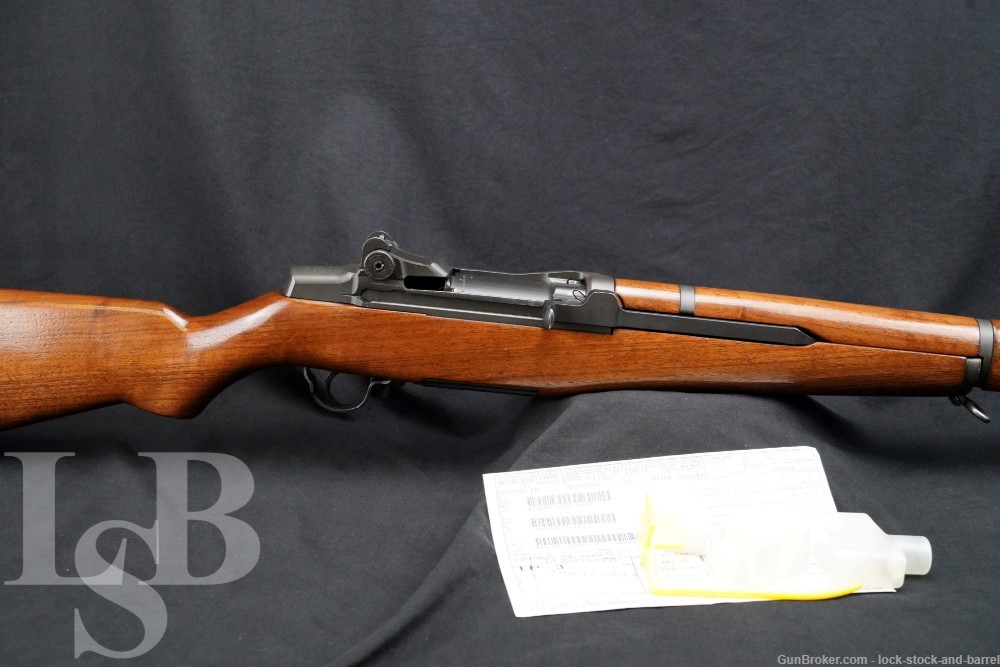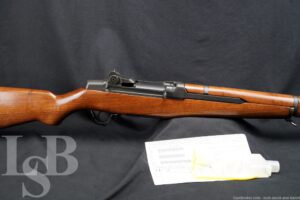
International Harvester M1 Garand U.S. .30-06 Semi Automatic Rifle US C&R
SOLD FOR: $3150
LSB#: 230501GB002
Make: International Harvester. The rifle’s action uses International Harvester parts. The LMR barrel is original. LMR supplied barrels to the International Harvester factory for assembly.
Model: M1 Garand.
Serial Number: 4573312
Year of Manufacture: 1953 to 1954. Barre Date: January 1954
Caliber: .30-06 Springfield
Action Type: Semi Auto, Fed by En Bloc Clips
Markings: There is no import mark. The gas cylinder lock screw is marked “NHC” and “IHC” – A Harrington & Richardson part (page 115 of Joe Poyer’s M1 GARAND 1936 to 1957, 6th Edition).
Receiver: “U.S. RIFLE / CAL. .30 M1 / INTERNATIONAL / HARVESTER / 4573312”
Trigger Group: “IHC D6528290” – An International Harvester part. (page 90 of Joe Poyer’s M1 GARAND 1936 to 1957, 6th Edition).
Hammer: “C-5546008 IHC”– An International Harvester part (page 98).
Safety: “IHC” – An International Harvester part (page 104).
Follower: unmarked – An International Harvester part used by others (page 83).
Receiver Leg: “D6528291-J” –Correct for a 1953 or 1954 dated International Harvester M1 Garand (page 758 of Bruce Canfield’s book, The M1 Garand Rifle).
Op Rod: “D-6535382 IHC” – An International Harvester part (page 72).
Bolt: “6528287 IHC / U” – An International Harvester part (page 52).
Barrel: “LMR” (Line Material Company of Birmingham, Alabama), “D6535448 1 54” and with other stamps – LMR provided barrels for International Harvester for assembly (pages 63 – 65).
The stock and sight are described below.
Barrel Length: Approximately 24 Inches
Sights / Optics: The front sight is a blade set between two protective wings. The rear sight is a fully adjustable aperture sight. The windage knob is marked “DRC” and “IHC”. The elevation knob is marked “IHC”. These are International Harvester rear sight markings (pages 39-40).
Stock Configuration & Condition: The face of the grip is marked with a “circled P” proof. The interior of the forearm is marked “2262”.
The three piece hardwood stock has a pistol grip, metal nosecaps, stacking loop, two sling loops, and a metal buttplate with hinged door for storage in the butt. The buttplate shows scrapes and light thinning. The stock shows several scrapes and scratches. The most prominent are on the belly of the stock. The LOP measures 13 inches from the front of the trigger to the back of the buttplate. The stock rates in about Very Good Plus overall condition as refinished.
Type of Finish: Parkerized
Finish Originality: Original
Bore Condition: The grooves near the muzzle are light gray. The remaining grooves are semi-bright. The rifling is deep. There is frosting in the grooves near the muzzle. The bore shows an M.E. of 0.9. The throat shows a T.E. of 2.
In this writer’s opinion, this bore rates 8 out of 10.
Many military and C&R-eligible weapons have bores that will show erosion. This is not only due to age but to the fact that corrosive primers were commonly used in ammunition worldwide. For example, the U.S. used corrosive ammunition throughout WWII. The U.S. military did not begin to phase out corrosive-primed ammunition until the 1950s.
Overall Condition: This rifle retains about 95% of its metal finish. The metal shows scuffs, handling marks, and a few small scrapes. The bottom rear of the receiver shows light thinning. The bottom of the op rod shows spots of moderate thinning from aggressive cleaning as well as discoloration. The action shows operational wear. The markings are clear. Overall, this rifle rates in about Very Good Plus to Fine condition.
Mechanics: The action functions correctly. We have not fired this rifle. As with all previously owned firearms, a thorough cleaning may be necessary to meet your maintenance standards.
Box, Paperwork & Accessories: The rifle comes with a shipping invoice from the Director of Civilian Marksmanship (DCM), the forerunner to the Civilian Marksmanship Program (CMP). The rifle was shipped from the Anniston Army Depot. The rifle also comes with a CMP chamber flag, sight protectors, and a charging handle protector.
Our Assessment: The M1 Garand had garnered a well-deserved reputation as the best standardized service rifle of WWII. At the end of WWII large numbers of Garands were in inventory and it was assumed they were sufficient to meet future military needs. That all changed when the Korean War broke out. Springfield Armory ramped up its Garand production line as quickly as possible, but additional sources were needed. On June 15, 1951, the Ordnance Dept. granted a contract to the International Harvester Co (IHC). International Harvester manufactured half-tracks, trucks and tractors during World War II. The firm had never made firearms. One of the major reasons behind the government’s selection of International Harvester was its location. Springfield Armory and Winchester were about 60 miles apart which was no longer desirable in a nuclear age. IHC is over 800 miles from Springfield and could continue production if there were a nuclear strike on the eastern seaboard.
In order to augment Springfield Armory’s and International Harvester’s M1 rifle production, a contract was also granted to the Harrington & Richardson Arms Co. on April 3, 1952.
International Harvester had a number of production issues which led them to subcontract the production of barrels to the Line Material Corp (LMR). It was soon widely acknowledged that the company’s barrels were of the highest quality. The high quality of the LMR barrels and their availability were among the few things to go smoothly with International Harvester’s M1 rifle production program.
IHC received production assistance from both Springfield Armory and H&R during the contract.
The International Harvester M1 Garand has since become one of the more popular M1’s due to the number of receiver variations and their relative scarcity as compared to Springfield Armory Garands of the same era.
This International Harvester M1 Garand was made between 1953 and 1954. It was later purchased from the Director of Civilian Marksmanship (DCM), the forerunner to the Civilian Marksmanship Program (CMP), and was shipped from the Anniston Army Depot. It looks great and has a strong bright bore.
The rifle’s action uses International Harvester parts. The LMR barrel is original. LMR supplied barrels to the International Harvester factory for assembly. Even the gas cylinder lock screw and rear sights are marked “IHC”. This is quite the collectible rifle.
…Now go shoot something!

